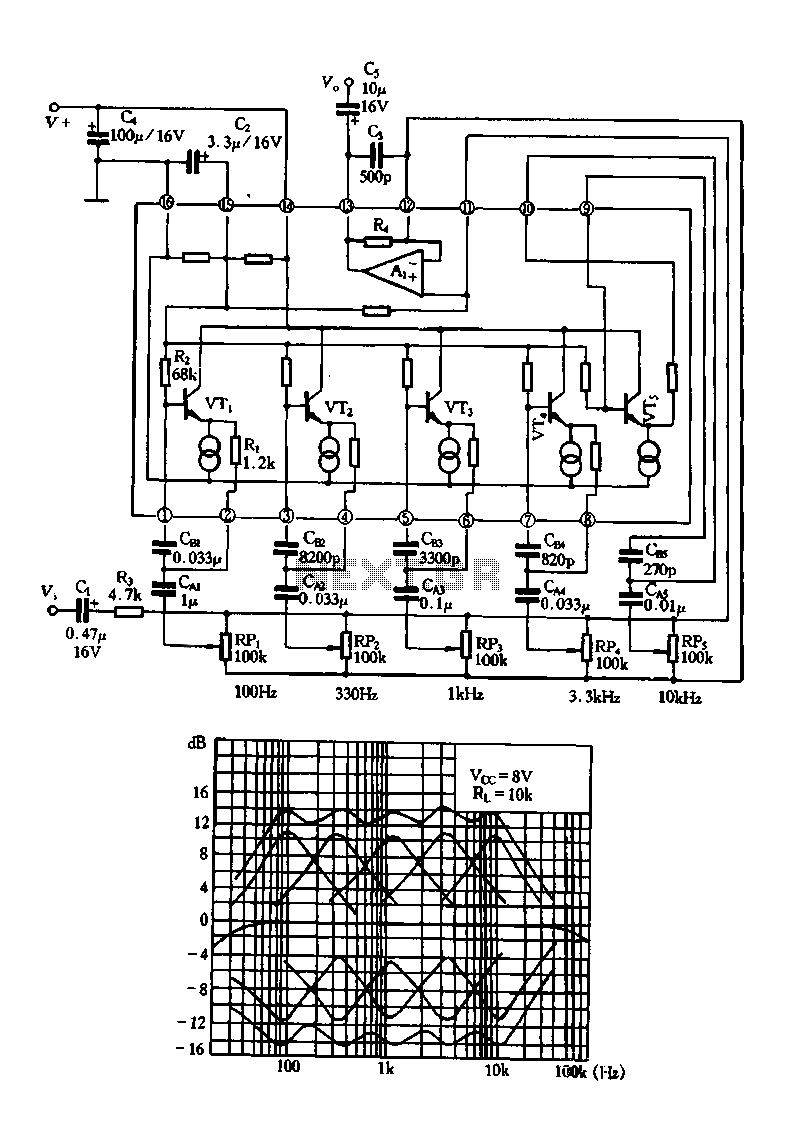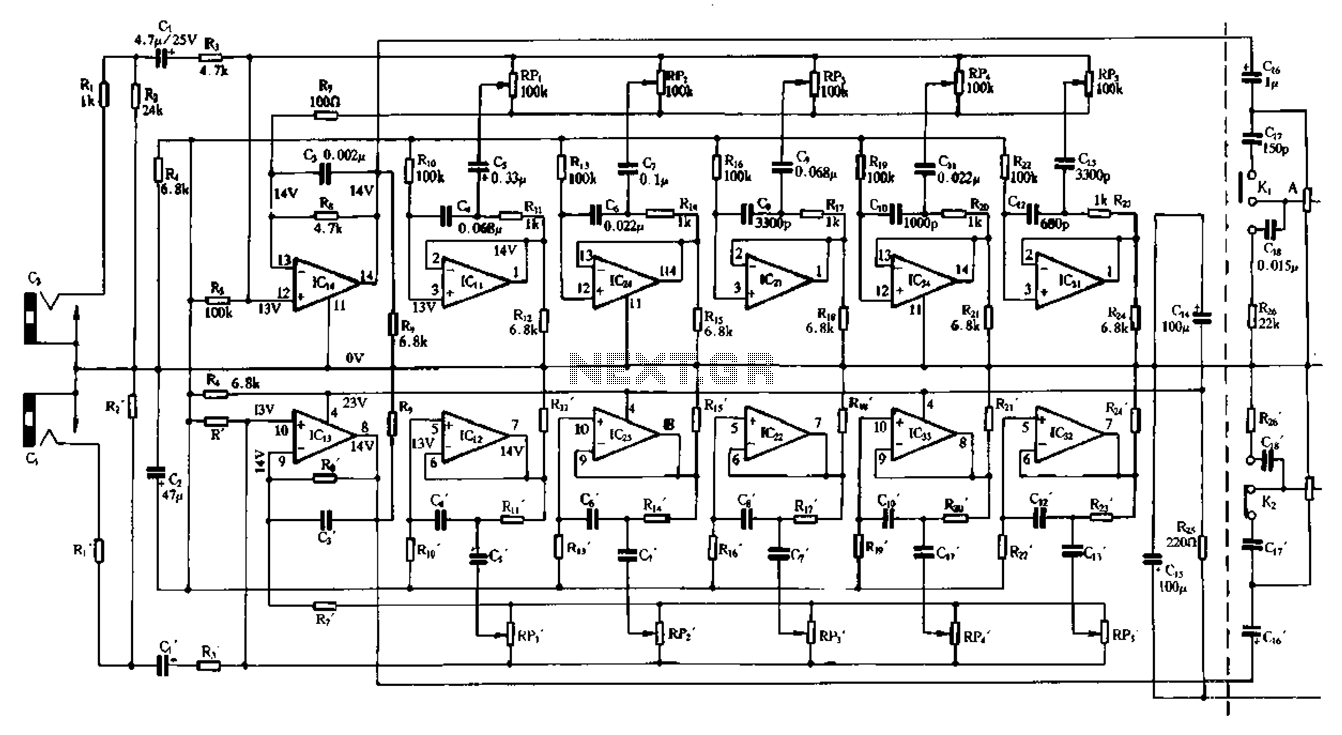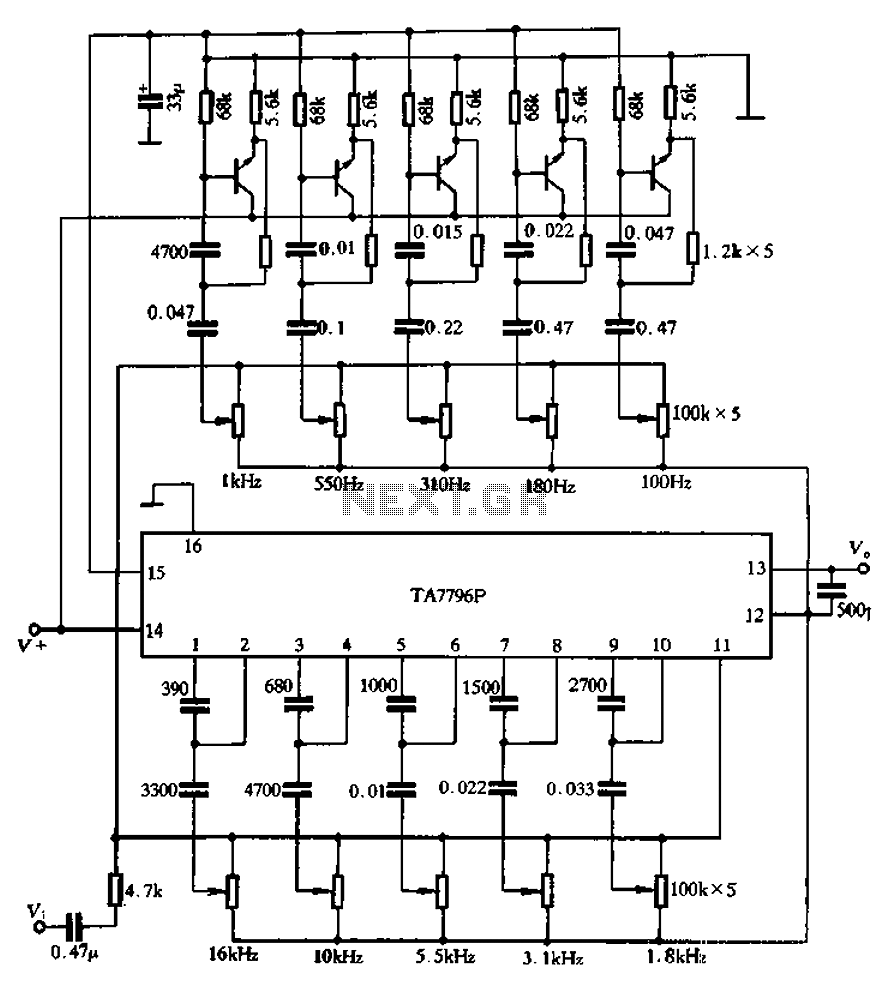
Composition equalizer with TA7796

Figure 1-99 illustrates a five-band equalizer circuit utilizing the TA7796 integrated circuit. This circuit is designed for public electricity voltage amplification and includes analog inductors integrated with transistors. The circuit features a common voltage operational amplifier (op-amp), with VTs and VTi functioning as analog transistors. Additionally, it incorporates external resistor and capacitor elements that simulate five inductances. These inductances and capacitances form five series resonant circuits, which are tuned to center frequencies of 100 Hz, 330 Hz, 1 kHz, 3.3 kHz, and 10 kHz.
The five-band equalizer circuit based on the TA7796 integrated circuit is engineered to enhance audio signals by allowing precise control over specific frequency ranges. Each band is designed to operate at a designated center frequency, enabling users to boost or attenuate the audio signal at those frequencies. The operational amplifier serves as the core of the circuit, providing the necessary gain to amplify the input audio signal effectively.
The use of analog transistors VTs and VTi allows for efficient signal processing within the equalizer. These transistors work in conjunction with the simulated inductors, which are created using external resistors and capacitors. This configuration enables the circuit to achieve desired frequency responses without the need for bulky inductors, making it suitable for compact electronic devices.
Each of the five resonant circuits is finely tuned to its respective frequency, ensuring that the equalizer can accurately manipulate the audio signal at 100 Hz, 330 Hz, 1 kHz, 3.3 kHz, and 10 kHz. This tuning is critical for achieving optimal sound quality and user satisfaction in audio applications. The design of the circuit also emphasizes stability and reliability, making it a viable choice for various audio processing tasks in both consumer and professional audio equipment.Figure 1-99 with a five-band equalizer equalizer circuit TA7796 specific integrated circuit composed of the circuit in the public electricity voltage amplifier, an analog induc tor in the transistors are integrated in a circuit. Where Ai is the common voltage op amp amplifier, VTs VTi-inductance is used as an analog transistors, and it included an external resistor and capacitor element five simulated inductance, five simulated inductance and capacitance, respectively ~ CA5 constitute five series resonant circuit, the center frequencies of 100Hz, 330Fk, 1 seven, 3,3 VII and 10kHzo
The five-band equalizer circuit based on the TA7796 integrated circuit is engineered to enhance audio signals by allowing precise control over specific frequency ranges. Each band is designed to operate at a designated center frequency, enabling users to boost or attenuate the audio signal at those frequencies. The operational amplifier serves as the core of the circuit, providing the necessary gain to amplify the input audio signal effectively.
The use of analog transistors VTs and VTi allows for efficient signal processing within the equalizer. These transistors work in conjunction with the simulated inductors, which are created using external resistors and capacitors. This configuration enables the circuit to achieve desired frequency responses without the need for bulky inductors, making it suitable for compact electronic devices.
Each of the five resonant circuits is finely tuned to its respective frequency, ensuring that the equalizer can accurately manipulate the audio signal at 100 Hz, 330 Hz, 1 kHz, 3.3 kHz, and 10 kHz. This tuning is critical for achieving optimal sound quality and user satisfaction in audio applications. The design of the circuit also emphasizes stability and reliability, making it a viable choice for various audio processing tasks in both consumer and professional audio equipment.Figure 1-99 with a five-band equalizer equalizer circuit TA7796 specific integrated circuit composed of the circuit in the public electricity voltage amplifier, an analog induc tor in the transistors are integrated in a circuit. Where Ai is the common voltage op amp amplifier, VTs VTi-inductance is used as an analog transistors, and it included an external resistor and capacitor element five simulated inductance, five simulated inductance and capacitance, respectively ~ CA5 constitute five series resonant circuit, the center frequencies of 100Hz, 330Fk, 1 seven, 3,3 VII and 10kHzo





